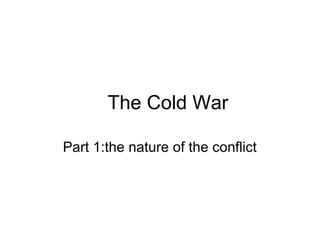
The Cold War Notes Part 1
- 1. The Cold War Part 1:the nature of the conflict
- 2. Tensions between the USA and USSR • After WWII, the USA and USSR were considered to be the only superpowers left in the world. • Despite being allies during WWII, the two sides had a hostile relationship due to a number of reasons. • The two sides would never directly engage each other in war, but rather resist each other in small conflicts spread around the world. • The long standing tension between the two sides became known as the Cold War. These tensions would last from 1945-1989.
- 3. Policy Differences between USA and USSR • The different economic systems of Communism and Capitalism were a large source of conflict between the two sides. • Communism (USSR): – Government ownership of industry, Government control of economy – Equal distribution of wealth • Capitalism (USA) – Private enterprise – Economy run on basis of supply and demand Communism Capitalism
- 4. Democracy vs. Dictatorship • Another source of conflict came from political differences between democracy and dictatorship. • America always valued democracy and personal individual freedoms (speech, religion, voting etc) • Soviet Union limited the freedoms of its people. Those who criticized the government were punished and imprisoned. Free elections were not held. A French political cartoon criticizing the USSR.
- 5. The Yalta Conference: 1945 • Origins of the Cold War could be seen at the Yalta conference. • The Yalta Conference was held early in 1945 when it seemed apparent that Germany would lose the war. • Winston Churchill (UK), Franklin Roosevelt (USA), and Josef Stalin (USSR) met to discuss the post war settlement. • At Yalta, Stalin was resistant to moving his troops out of the areas that he had taken from Nazi Germany. The Allies decided to allow him to keep influence over those areas in exchange for help with defeating Japan and support for the new UN.
- 6. The Iron Curtain •Stalin used his influence over these areas to install communist “puppet” governments in several countries to the west of the Soviet Union. These countries basically did whatever Stalin and other leaders of the USSR told them to do. •Upset at this development, Winston Churchill gave a famous speech in which he declared that an “iron curtain” had descended on E. Europe and the people living east of the Iron curtain were being shut off from the light of democracy and capitalism. •The “Iron Curtain” was not an actual physical barrier, but a metaphor for the division of Europe between Capitalism and Communism USSR 1 2 3 4 5 6 The Iron Curtain (1. E. Germany, 2 Poland, 3. Czechoslavakia, 4. Hungary,5 Romania 6. Bulgaria) were all newly communist countries under the influence of the USSR.)
- 7. Nuclear Weapons • The Soviet Union was able to develop a nuclear weapon by 1949, and the possession of nuclear weapons had an enormous influence on the conflict. • Nuclear weapons made each side fear the other’s power and caused tension, but in many cases it also led to cooperation between the two sides as they knew they could not risk direct conflict. The Bravo H-bomb on Bikini Atoll was the largest US above ground nuclear test. The blast was measured at 10-15 megatons. It was over a thousand times more powerful than the bombs dropped on Japan.
- 8. The Theory of Deterrence • The theory of deterrence suggested that you should show strength in order to prevent or deter your enemy from attacking. • Each side built up their nuclear arsenal in an attempt to show the enemy that any attack would be met with a counter-attack. • This theory is sometimes referred to as Mutual Assured Destruction (MAD). MAD helped keep peace between the two sides, The Three delivery systems for nuclear weapons made deterrence possible Submarine Bomber ICBMs
- 9. Containment • Even before the USSR developed nuclear weapons, the US feared a direct conflict believing it would be a long and deadly war. • Instead the US adopted the policy of containment, deciding that it was safer to try and prevent communism from spreading than to try and overthrow current communist governments. • This policy was first put to use under US President Harry Truman as he gave money and military supplies to defeat communist revolutions in Greece and Turkey. In a statement known as the Truman Doctrine, America declared that containment would be their foreign policy in dealing with the Soviets. The Truman Doctrine helped define America’s role in post war Europe.
- 10. Alliances • The Cold War did not just involve the US and USSR. • In order to prepare for a possible war between the two sides, alliances were formed. • NATO (North Atlantic Treaty Organization) was formed in 1949 and consisted the US and its allies (W. Europe and Canada). • In response, the USSR formed its own alliance known as the Warsaw Pact in 1955. The Warsaw Pact contained the USSR and E. European countries.
- 11. Cold War Alliances NATO • USA • UK • France • Canada • Belgium • Denmark • The Netherlands • Italy • W. Germany • Norway • Greece • Turkey Warsaw Pact • USSR • Poland • Czechoslovakia • E. Germany • Hungary • Romania • Bulgaria